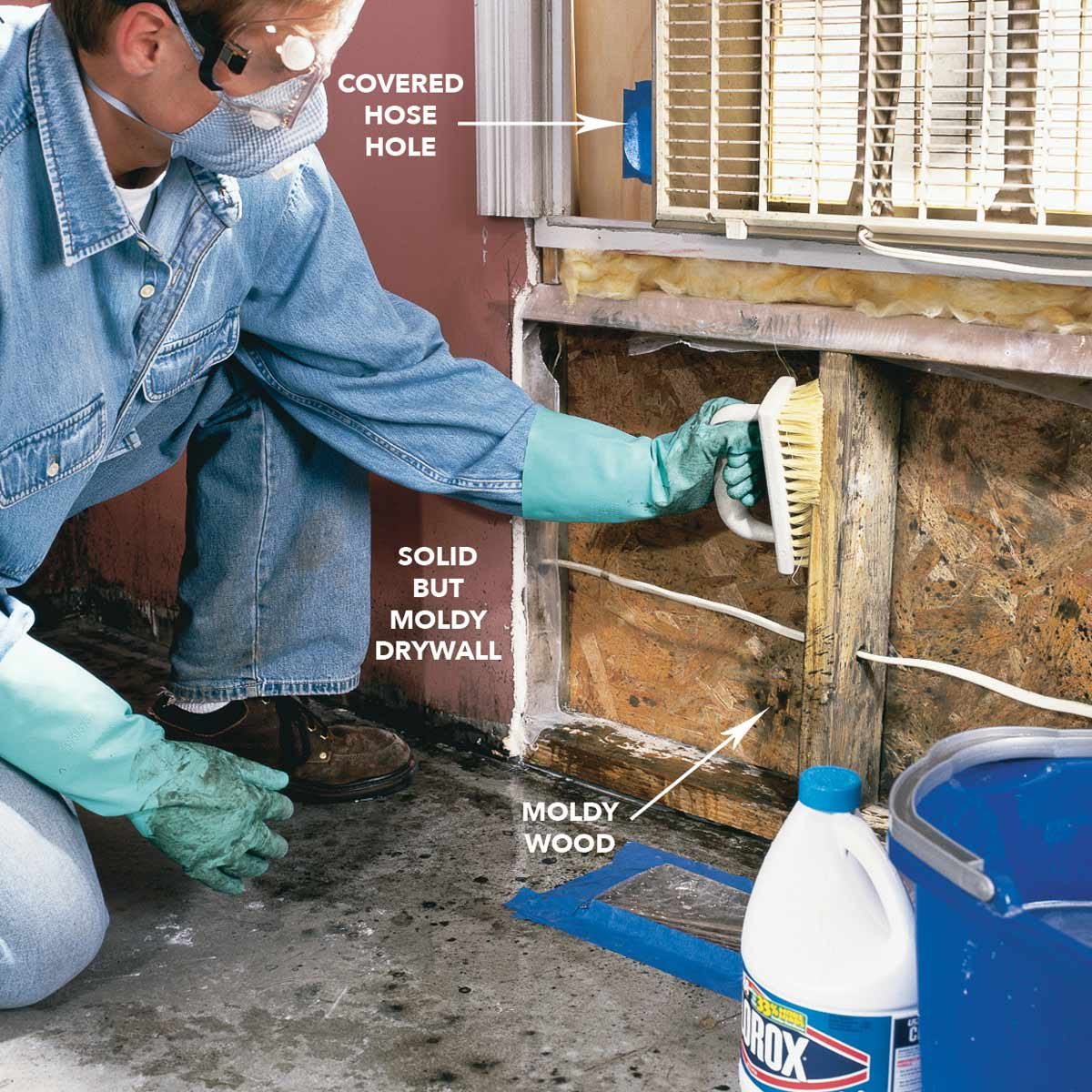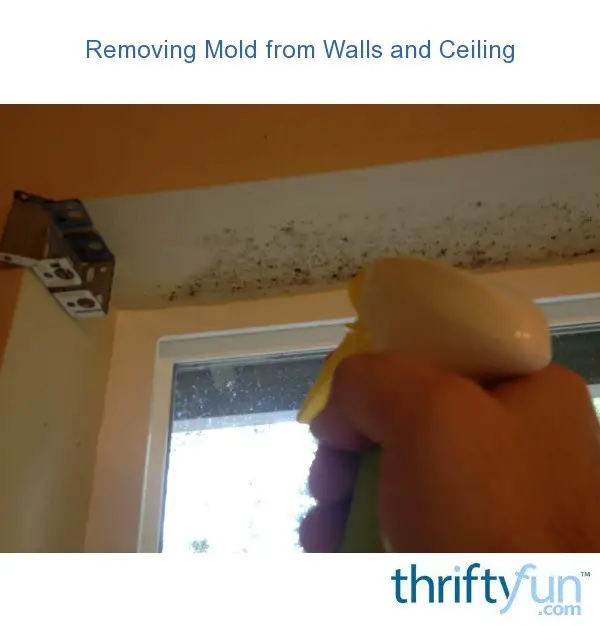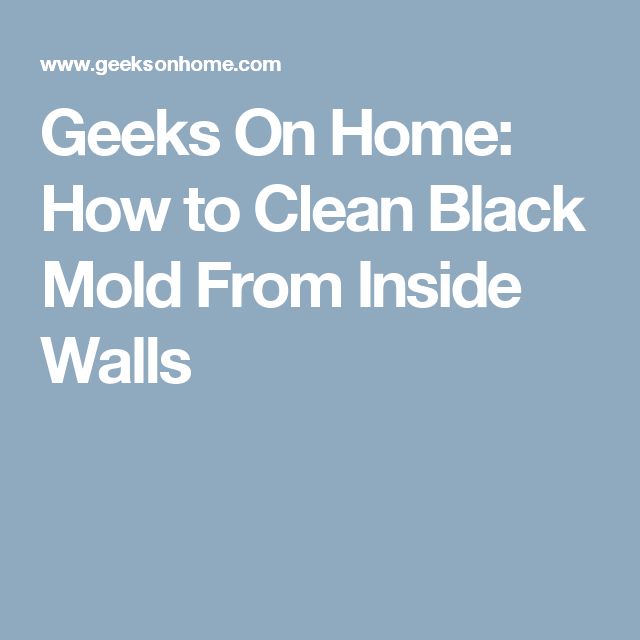Other Types Of Mold On Walls
Black may be the image you picture in your mind when you think about mold on walls. These spores actually come in many different colors and each color presents a different type of mold. Grey, olive-green, brown, blue, green and white molds are all commonly found on walls. Each color is a different type of fungus, but all molds must be killed and cleaned out of the home immediately. Left undisturbed, any color of fungi spores will continue to grow and spread in damp areas. No matter what color of spores you are seeing, know that it is harmful to your lungs and health. Access the area and decide the best way to clean and disinfect the area.
How Often To Clean Mold Off Walls
Mold should be removed as quickly as possible once it is discovered. Even if you don’t see mold growth, there are signs of a potential mold problem that can help you prevent the colony from growing out of control:
- You detect a musty smell in your home. The odor signals a mold problem that needs to be addressed.
- You have neglected a leaky faucet or roof.
- A wall that feels soft or damp to the touch may indicate that there is interior mold growth that will soon appear on the surface.
- There is moisture accumulation that takes a long time to evaporate from walls due to poor ventilation in the house.
Signs You Have Mold Inside Your Walls
Ive since learned that there are several ways to detect a mold problem, but you have to know what you are looking for. Certainly, seeing moldy materials growing on the surface of your walls is the most obvious sign that you could have mold on the inside of your walls.
However, mold growth inside of a homes walls is not always evident from signs on the surface. Mold can grow within the walls without showing visible evidence of growth. So how do you know if you have a mold problem? These signs can help you pin down the issue:
· Smell
You may detect a musty or earthy odor. This can come from the wall itself or from your heating or cooling system. Your ventilation system could be picking up smells from the mold-affected area and distributing the mold spores throughout your home.
Mold often smells worse when the area is wet. If the mold has resulted from a leak that is unrepaired, the odor may come and go when it rains or snows. You may continue to notice a smell in the days following a rain storm.
· Dampness
If your wall exhibits any damp areas, prepare for the possibility of mold growth. Mold thrives in humid or wet conditions and requires water to grow.
Porous surfaces are apt for mold infestation. Areas of high humidity, leaking water, or condensation can also lead to mold spread. Check the walls as well as any nearby carpeted areas.
· Stains
· Flood or Leak
· Health Symptoms
Don’t Miss: How To Clean Mold Off Shower
How To Prevent Mould On Walls
Mould thrives in damp conditions and the wet seasons and high humidity found throughout Australia make for perfect mould growing conditions. Here are some steps you can take that will help prevent mould growth in your home.
If you have a mould problem then it really pays to call in the experts. We can get to the source of your mould problem and make sure it doesnt come back.
See Also:
Donât Miss: How To Find Source Of Mold Smell In House
Can I Just Get Into The Wall And Use Bleach To Clean It

It may be tempting to get into the wall and spray everything with bleach by yourself. However, if you have never done this before, it is better to call someone licensed to deal with mold. This is especially true if you have never gone into the wall and dont know how to detect how extensive the mold damage is. Leaving the eradication of mold to professionals will save not only your health but also your sanity. A professional team will have all the protective gear, detection tools and methods necessary to get rid of all the mold in your home.
Read Also: Does Insurance Cover Mold In House
For Help Removing Mold In Walls
If you need help removing mold in your walls, or if you’d just like some advice about the mold removal process, we suggest scheduling a free consultation in your home with a mold removal professional. There’s no obligation on your part, so even if you opt to handle the mold removal job yourself, you can benefit from some free professional guidance. To find qualified mold removal professionals offering free consultations in your area, you can follow the link.
How To Remove Mold From Walls For Good
This post may contain selected affiliate links. See the disclosure page.
Get rid of mold on your walls with these easy homemade sprays, then keep it from returning for good.
Just about every home develops mold at some point. Surprisingly, newer homes get it more often because their tighter seals around windows and doors make them retain more moisture than drafty old homes.
You May Like: Do Mold Bomb Foggers Really Work
Avoiding Future Mold Problems
When the wall is open, it is necessary to find the source of the water leak in order to stop the moisture that is accumulating within the wall. Also, be sure to completely dry the area before closing it back up, because even a slight amount of moisture can result in mold growth.
The wall studs should be replaced if possible. If they can’t be replaced the studs should be cleaned as best as you can, and then encapsulated. Be sure that you are wearing protective goggles and a mask, and seal off the room so that mold spores do not travel through the rest of the building. Professional sometimes will sand down moldy wood to get to all of the mold, but that is too dangerous of a job for the average homeowner.
It is possible to do-it-yourself if you have black mold inside walls, but a better option is to call a professional to take care of the problem for you. Mold specialists are familiar with how to remove black mold from wall materials, and they will be able to handle any situation that they find within the walls.
A professional company has all of the equipment that is needed to clean up the mess, and they will be able to do it quickly in order to reduce the amount of time that your family is exposed to mold. Using a specialist is safer for your family, and it will give you peace of mind to know that you dont need to worry about mold problems in the future.
How To Get Rid Of Mold On Bathroom Walls
Bathroom mold is an unsightly and unhealthy problem that should be addressed as soon as you spot it. For mold on painted walls, try a natural remover. Learn more here.
Bathroom mold is an unsightly and unhealthy problem that should be addressed as soon as you spot it. The most common places to find mold are tile grout, caulk and painted or wallpapered walls.
Bathroom mold occurs primarily because mold loves damp, dark, isolated spaces, says Larry Vetter of Vetter Environmental Services in Smithtown, N.Y. Typically, a bathtub, shower, or entire bathroom remains damp enough for mold growth just from showering or bathing.
Chances are, if youre reading this, you already have a mold problem in your bathroom. In that case, there are some simple steps you can take to get rid of that mold.
Don’t Miss: How To Clean Mold From Leather Car Seats
Are There Any Other Lesser
Then we come to our lesser-known but just as effective remedies for black mould. The first, using a popular hair dye treatment, includes hydrogen peroxide. It is not great for the environment, but a quick and easy way to eradicate small black mould areas from your stone walls. We are using just a spray bottle and a cloth.
The second is far more environmentally friendly and, as such, is one of the more popular at-home treatments, relying only on the natural power of tea tree. Tea tree oil and water, this solution should sprinkle onto the moulded area until entirely saturated and then left. Thats right, no rinsing, as the tea tree can sit harmlessly on the stone surface and prevent future mould from sprouting.
White vinegar is another at-home method using your cupboard contents and using either a 100% white vinegar solution or a mix of the vinegar and water for a smaller area of mould. This solution should be applied and allowed to dry on the surface to be fully active.
Find Professional Mold Remediation Services
Black mold in a home should be addressed quickly and correctly. At Mold Remediation, we have the latest technology to remove severe mold infestations properly. Additionally, our mold remediation professionals know the best methods for containment and removal of mold spores so they do not contaminate surrounding areas during removal. Contact us today to learn more about our mold removal services.
Recommended Reading: Can You Use Bleach To Get Rid Of Mold
Recommended Reading: Can You Get Rid Of Mold In Your House
How To Clean Mold From Concrete
The best solution is to scrub and clean the affected areas with a mold-killing detergent, like RMR-86 Instant Mold & Mildew Stain Remover, or a simple solution of household bleach and water. Be sure to scrub aggressively to get down into the pores of the concrete. Let the detergent or bleach solution soak in for a while to ensure that all the mold is killed. After scrubbing, rinse with a power washer to get all the solid organic matter out of the concrete.
Once youâve tackled the mold you can add color or an overlay to completely transform your concrete!
Recommended Reading: How Do I Get Mold Off Of Wood
Removing Mold From Interior Walls

To clean off mold from porous surfaces like wood and drywall, a detergent should be added to a bleach and water solution to help it adhere.
Also Check: Will Black Mold Hurt You
Don’t Miss: How To Get Rid Of Mold Spores In Basement
How To Remove Black Mold From The Drywall Easy Steps
Black mold is usually found on drywalls as they are a major source of food for them. Our homes are our sanctuary and if this sanctuary is ruined by something black mold sticking over our beautiful walls, we would definitely get upset. Not only this, did you aware that drywall mold can cause major respiratory problems? Its critical to get rid of mold as soon as you detect its starting to grow. Depending on whether the walls are painted or not, several methods for killing mold are used. If the drywall is coated, washing it is as simple as using water and a suitable cleaning chemical. When the wall isnt painted, however, the work becomes much more difficult.
Hopefully, our black mold removing guide below will be a huge help in providing you with the perfect solution to get rid of mold spores from your house.
How Much Does A Los Angeles Mold Removal Company Charge To Remove Mold From Inside Walls Gene West Hollywood
This truly depends on the extent of the mold growth and what caused the mold in the first place, how wet are the walls, is it a large wall area, small wall area.
All these play an important factor in cost.
The range we have charged here at the Twin Home Experts over our 37 years performing mold cleaning is a high of $12,300.00 for some extreme cases and a low of $950.00 for very light and small cases.
Recommended Reading: What To Use On Mold On Wood
How To Get Rid Of Mold On Fabric
Those damp towels or gym clothes forgotten in a bag create an environment where mold can flourish if left too long. If you spot mold on these fabric items, here’s how to nix it:
- Bring the item outside and brush off the excess mold to prevent the mold spores from getting inside your home.
- If the fabric is machine washable, rub in liquid laundry detergent and wash it on the hottest setting possible according to the care instructions with chlorine bleach or non-cholorine bleach, as specified by the care instructions.
- If the fabric is not machine washable, dry cleaning or hand washing will remove the mold.
First Can I Remove Mold Myself
Subscribe to our membership program for full digital access plus exclusive content, deals and more.
You can, but mold spores can travel in the air when cleaning, so youll want to limit your exposure by wearing protective gear. Wear long rubber gloves to protect your hands and forearms. Its also best to wear eye protection, like goggles, to prevent bleach or other cleaners from splashing in your eyes, especially when removing mold from ceilings or overhead areas.
If the mold problem is severe and more than a few spots, it could be a sign of a bigger moisture problem. If the area is widespread and larger than approximately a 2 x 2 foot area, you’ll want to call in a pro to have it removed safely.
Recommended Reading: Where To Buy Bath Bomb Molds
Remove Mold From Concrete And Cement Walls
Removing black mold from concrete or cement walls is fairly simple. However, in some situations, it may be difficult to completely remove all traces of it, especially if it has gotten deep into the concrete. In this situation, it may be necessary to apply an encapsulation to help seal in any remaining traces of spores, which will prevent it from growing and spreading.
Simple Tips To Reduce Condensation & Black Mould
Mould on walls is often the result of excess moisture in the air, leading to condensation. These simple tips help you reduce the amount of moisture in the air.
For more tips on reducing condensation in specific areas, check out our following guides:
Don’t Miss: How Can You Clean Mold Off Walls
Close And Rebuild The Wall
Unfortunately, it is often necessary to tear out drywall to do effective mold removal from inside a wall. Once all the cleanup and treatment of the interior surfaces is completed, you will need to rebuild the area. Put in new insulation and install new drywall. When painting, choose a good mold killing primer that applies a fungicidal protective coating.
Keep The Humidity Low

A humid environment can encourage mold regrowth in the future. Do your best to keep the space dry and mold-free by minimizing the humidity levels. Use a dehumidifier to keep the humidity between 30 and 50 percent to deter mold from growing in other areas.
Following these steps will help you remove mold from your drywall surfaces and discourage it from growing back.
Don’t Miss: How To Eliminate Mold On Drywall
Removing Mold From Wallpaper
Use the natural mold remover spray on finished, painted, or wallpapered surfaces. Spray the area well, then immediately scrub it with a clean cloth or brush to remove the surface layer of mold. Then lightly respray the area, using only enough to dampen the spot you dont want it dripping. Wait 10 minutes and wipe it with a clean, fresh cloth. Let it dry overnight without rinsing the remaining acetic acid from the vinegar will work overnight to finish killing mold you cant see.
Also Check: How To Get Rid Of Airborne Mold
How To Remove Mold From Wood
In areas like the kitchen, where there’s higher humidity from cooking or running the dishwasher, you may find mold on your wood cabinets if there is poor ventilation. Mold can also grow on wood furniture and paneling if it’s humid and the air circulation is low. To remove mold from wood cabinets, paneling, or furniture, follow the steps below:
- Using a vacuum with a HEPA filter , vacuum the loose spores with the soft brush attachment.
- Then, mix a few drops of dish detergent, like Dawn Platinum, with a gallon of water and use a rag to apply the solution. Wet the surface to remove the mold but do not saturate it.
- Follow-up with a cloth dipped in clear water, wring it out well, and wipe the surface dry. Don’t let the wood stay wet for too long as it could damage the finish.
Recommended Reading: Does Vinegar Kill Mold On Drywall
Removing White Mold On Walls In Bedroom
Your bedroom is supposed to be where you start and end your day, which is why it should be the most comfortable room in your home. However, white mold growing on your bedroom walls can change all that!
Some people have asked Can mold on walls make you sick?
The answer is yes since mold can cause allergies and make respiratory illnesses worse. Besides, having mold on your walls is an eyesore, and getting rid of it should be a top priority.
Follow these tips to remove white mold from bedroom walls.